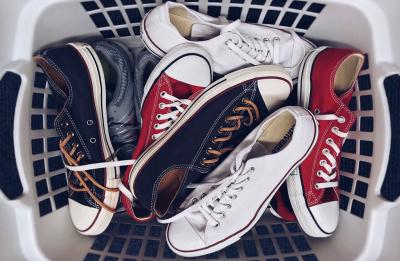Snazzy Sneakers: Project Overview

Submitted by: Denise W. Carlson, ITL Program, College of Engineering and Applied Science, University of Colorado-Boulder
- Equipment Used: 3D Printer, Router, Hand Tools
- Time Required: 2 hours
For this project, students decide on specific design requirements such as good traction or deep cushioning. Some sneakers provide soles with support, cushioning, flexibility and traction for playing a sport. Some sneakers are intended to be fashionable with cool colors, materials or added height.
Students sketch their plans and then use a variety of materials to build prototype shoes that meet the design criteria. Sneakers are engineered products that use a mix of materials to create highly functional, useful shoes.
Scenario, Criteria and Constraints
These days, sneakers are so specialized! What different kinds of sneakers can you think of? (Listen to student ideas.) You can see that it is important to have design criteria in mind when you create footwear like sneakers. The way shoes are made, and the materials that are used depend on the intended purpose and end-use.
Why might engineers be involved in the design of sneakers? Well, while it is important for sneakers to look stylish to appeal to buyers, they must also function correctly. The best designs combine physics, biomechanics and materials science. Engineers take advantage of a wide range of materials and inventive structural designs to provide durability, comfort, cushioning and stability.
Many factors must be taken into consideration when designing sneakers, such as who will wear them and for what types of activities. For example, women's feet are usually narrower with higher arches than men's feet. The end-user and activity type dictates what shoe requirements are most important for the design, such as traction, cushioning, flexibility and sole thickness.
What are your ideas for a sneaker that has never been made before? Think about the type of sneaker you want to create. Define its specific characteristics. Sketch your design and select materials. Then create and test a prototype (a working model)—just as engineers do.
Materials
You'll need an assortment of materials to provide cushioning, support, protection, flexibility, height and/or traction for shoe prototype construction. Materials could include fabric, canvas, sponges, foam-packing material, foam core board, rubber gloves, rubber baseboard, sandpaper, Brillo pads, paint. You'll also need an assortment of fabrication tools and adhesives to work with the materials, such as scissors, twine, glue, and tape.
Learning Outcomes
After completing this activity, students should be able to:
- Analyze a product's components and functions.
- Recognize a design need or engineering challenge.
- Develop, sketch and discuss possible solutions and select one.
- Select appropriate materials for a design solution.
- Construct a working model using a variety of materials.
- Use, evaluate and suggest ways to improve a product.





